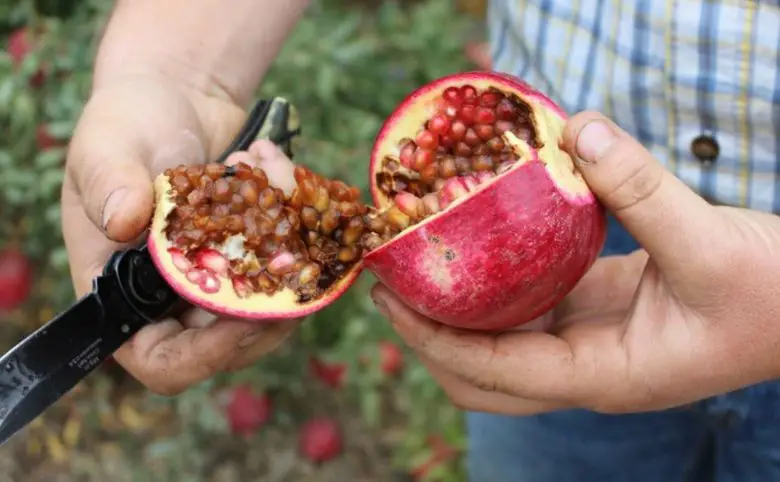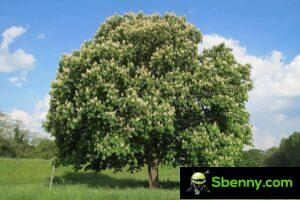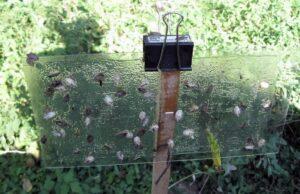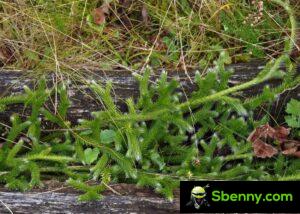The pomegranate it is an increasingly cultivated fruit tree, both for the fresh market and for processing into juices, with world production constantly increasing. This also applies to our country, where new plants have multiplied in recent years. Unfortunately, the increased cultivation also leads to the appearance of new problems, especially as regards fungal diseases. One is causing serious concern among growers, professional and otherwise, namely the black heart of the pomegranate. Have you ever opened a seemingly healthy pomegranate and found it instead march inside?
Here, this is the problem of the black heart, or of thepomegranate alternaria.
In this article, we therefore try to understand more about this cryptogamic disease.
What is pomegranate alternaria

L’Alternaria spp is a large genus of ascomycete mushrooms, of the class Dothideomycetes, which includes over 300 species. The most common form is Alternata alternata and it is feared that this pathogen is responsible for the black heart of the pomegranate.
This fungus is very resistant and is able to survive in saprophytic form (mycelium) for many years in the soil, or on decomposing vegetation residues or on affected and mummified fruits that are not harvested.
How pomegranate alternaria affects
The alternaria pathogen of the pomegranate penetrates inside the fruit from the calyx area, causing the progressive rotting of the arils, hence the common name of black heart. When opening an affected fruit, the rot can be brown (so-called soft form) or completely black (dry form).
The serious problem with this pomegranate disease is that the fruit almost always appears perfectly healthy externally. It is generally not the entire production of the plant that is affected, but a variable percentage of 5 to 50% (peaks found in Greece and Israel). This involves the risk that the fruit, inedible and unusable for juices, ends up in the shopping cart of the unsuspecting consumer who, after opening it, finds himself in front of a bitter surprise. This factor that is difficult to control compromises in a certain sense the “reputation” of the pomegranate, with the possibility of an overall drop in market demand.
External symptoms of pomegranate black heart
We have said that on the fruit it is difficult to detect the symptoms of an alternaria attack. At most, a darker coloration of the skin with black dots can be observed, insufficient signs to notice with certainty the presence of the disease, especially to an inexperienced eye and in the agitated phases of the collection.
It is easier to understand that an alternaria attack is underway by observing the leaves of the tree, which can show pinpoint black spots, yellowing and falling off early. Obviously not all the vegetation is affected, therefore also this factor is not entirely exhaustive for the early recognition of the disease, at least in the pomegranate crops intensive.
Period of greatest risk for the pomegranate alternaria
According to several field trials this pathogen generates the disease in certain conditions. Generally, the pomegranate alternaria strikes in late spring, in the period between flowering andfruit set. In practice, the fungus penetrates the newly formed fruit and develops hand in hand with it, causing the rotten black heart.
The vectors can also be pollinating insects. The main way of entry is micro-lesions on the peel of the fruit.
The predisposing environmental factors are the mild climate associated with very rainy periods, conditions that are not difficult to find in spring.
How to prevent pomegranate black heart naturally
To prevent the onset of the black heart of the pomegranate, it is first of all necessary to work on the best possible cultivation conditions. First of all, the soil must be well drained and not give rise to water stagnations which favor the alternaria pathogen. Excessive fertilizations must be avoided, which cause a vegetative re-explosion also favorable to the fungus.
Summer water stress must be avoided, guaranteeing regular irrigation and thus avoiding the classic one pomegranate splitanother possible route of entry for the pathogen.
During the vegetative rest it is necessary prune pomegranate the right way, aerating the vegetation. The more air circulates between the plants, the less chance there will be of relative humidity conditions favorable to the fungus.
Finally, if plants and fruits have been affected by Alternaria, at the end of the season it is necessary to remove residues of vegetation and potentially infected mummified fruit from the field and therefore a source of inoculation of the fungus in the following season.
How to prevent pomegranate black heart with organic remedies
There are few treatments with products allowed in organic farming that can be carried out to prevent the black heart of the pomegranate. First you can use the classic fungicides based on cupric salts. Another usable product is the sulfur, especially that in liquid formulations.
As microbiological products against pomegranate alternaria are being tested the bacillus subtilis and the bacillus amyloliquefaciensvery common bacteria in the soil, but with still few applications in the field that test their efficacy against the specific pathology with certainty.
In any case, all treatments must be carried out immediately after the end of flowering, thus respecting the precious action of pollinating insects, essential for having satisfactory pomegranate productions.







Start a new Thread